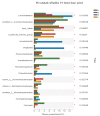An Analysis of the Colony Structure of Prokaryotes in the Jialing River Waters in Chongqing
- PMID: 35564921
- PMCID: PMC9101644
- DOI: 10.3390/ijerph19095525
An Analysis of the Colony Structure of Prokaryotes in the Jialing River Waters in Chongqing
Abstract
At present, research on the influence of human activities (especially urbanization) on the microbial diversity, structural composition, and spatial distribution of rivers is limited. In this paper, to explore the prokaryotic community structure and the relationship between the community and environmental factors in the Jialing River Basin of Chongqing, so as to provide a basis for monitoring microorganisms in the watershed. The V3-V4 region of the 16 S rRNA gene was analyzed by high-throughput sequencing and the microbial community of the waters of the Jialing River was analyzed for the diversity and composition of the prokaryotic community as well as the species difference of four samples and correlations with environmental factors. The main results of this study were as follows: (1) The diversity index showed that there were significant differences in the biodiversity among the four regions. At the genus level, Limnohabitans, unclassified_f_Comamonadaceae, and Hgcl_clade were the main dominant flora with a high abundance and evenness. (2) A Kruskal-Wallis H test was used to analyze the differences of species composition among the communities and the following conclusions were drawn: each group contained a relatively high abundance of Limnohabitans; the Shapingba District had a higher abundance of Limnohabitans, the Hechuan District had a wide range of unclassified_f_Comamonadaceae, and the Beibei District had a higher Hgcl_clade. (3) Through the determination of the physical and chemical indicators of the water-namely, total nitrogen, total phosphorus, chemical oxygen demand, chlorophyll A, and an analysis by an RDA diagram, the results demonstrated that the distribution of microbial colonies was significantly affected by the environmental factors of the water. Chemical oxygen demand and ammonia nitrogen had a significant influence on the distribution of the colonies. Different biological colonies were also affected by different environmental factors.
Keywords: biological information analysis; community structure; high throughput sequencing; prokaryotes.
Conflict of interest statement
The authors declare no conflict of interest.
Figures










Similar articles
-
[Bacterioplankton Community Structure in the Lancang River Basin and the Analysis of Its Driving Environmental Factors].Huan Jing Ke Xue. 2018 Aug 8;39(8):3649-3659. doi: 10.13227/j.hjkx.201711014. Huan Jing Ke Xue. 2018. PMID: 29998671 Chinese.
-
[Structure and Function of Fungal Community in Channel Sediments of Different Sections of Jialing River].Huan Jing Ke Xue. 2024 Jul 8;45(7):4006-4013. doi: 10.13227/j.hjkx.202307209. Huan Jing Ke Xue. 2024. PMID: 39022948 Chinese.
-
Nonpoint Source Pollution (NPSP) Induces Structural and Functional Variation in the Fungal Community of Sediments in the Jialing River, China.Microb Ecol. 2023 May;85(4):1308-1322. doi: 10.1007/s00248-022-02009-5. Epub 2022 Apr 13. Microb Ecol. 2023. PMID: 35419656
-
Sequencing Insights into Microbial Communities in the Water and Sediments of Fenghe River, China.Arch Environ Contam Toxicol. 2016 Jul;71(1):122-32. doi: 10.1007/s00244-016-0277-5. Epub 2016 Apr 6. Arch Environ Contam Toxicol. 2016. PMID: 27053089
-
Shift in the microbial community composition of surface water and sediment along an urban river.Sci Total Environ. 2018 Jun 15;627:600-612. doi: 10.1016/j.scitotenv.2018.01.203. Epub 2018 Feb 3. Sci Total Environ. 2018. PMID: 29426184
Cited by
-
Assessing the Ecotoxicity of Eight Widely Used Antibiotics on River Microbial Communities.Int J Mol Sci. 2023 Nov 30;24(23):16960. doi: 10.3390/ijms242316960. Int J Mol Sci. 2023. PMID: 38069283 Free PMC article.
-
Effects of rearing systems (cage versus floor) on the microbial composition and transcriptome of goose ileum.Front Vet Sci. 2024 May 23;11:1394290. doi: 10.3389/fvets.2024.1394290. eCollection 2024. Front Vet Sci. 2024. PMID: 38846790 Free PMC article.
References
-
- Findlay S. Stream Ecosystems in a Changing Environment. Academic Press; Cambridge, MA, USA: 2016. Stream Microbial Ecology in a Changing Environment; pp. 135–150.
-
- Simon M., Grossart H., Schweitzer B., Ploug H. Microbial ecology of organic aggregates in aquatic ecosystems. Aquat. Microb. Ecol. 2002;28:175–211. doi: 10.3354/ame028175. - DOI
-
- Ping X., Leff L.G. Longitudinal changes in the benthic bacterial community of the Mahoning River (Ohio, U.S.A.) Hydrobiologia. 2004;522:329–335.
Publication types
MeSH terms
Substances
LinkOut - more resources
Full Text Sources

